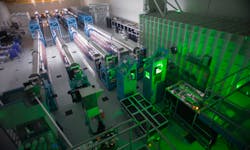Rochester Laboratory for Laser Energetics receives $82 million in funding
U.S. Senate Minority Leader Charles E. Schumer (D – NY) and U.S. Senator Kirsten Gillibrand (D – NY) have pushed to secure $82 million in funding for the OMEGA Laser Facility at University of Rochester Laboratory for Laser Energetics (LLE; Rochester, NY). The funding comes as part of $575 million that the senators fought to deliver to the National Nuclear Security Administration’s (NNSA) Inertial Confinement Fusion (ICF) program in the bipartisan FY 2021 appropriations package.
The funding will help achieve scientific milestones laid out in the current five-year Cooperative Agreement between LLE and the NNSA, and will provide resources to help support the science-based stewardship of the nation’s nuclear weapon stockpile. It will also support nearly 900 jobs for scientists, engineers, technicians, and support staff, helping to drive economic growth throughout New York State.
Established in 1970, the LLE is the largest U.S. Department of Energy (DOE) university-based research program in the U.S. and is home to the OMEGA lasers (Omega and Omega EP), two of the largest and most capable at any academic institution in the world. The funding will allow LLE to support facility operations and experiments on OMEGA in order to make progress on the three most viable approaches to fusion, as well as support the research programs of the three NNSA laboratories. With this support, LLE will also be able to provide the needed scientific and technical support for external users, including the national laboratories (LLNL, LANL, and SNL) and more than 400 scientists from over 50 universities, that conduct research at the OMEGA facility. Lastly, this funding will improve cyber infrastructure and enhance the security of new high-performance computing capabilities, accelerate development and deployment of state-of-the-art diagnostics and next-generation laser technologies that have long-distinguished the University.
NNSA’s ICF Program helps to maintain the OMEGA Laser Facility. The ICF program is critical to maintaining safe, secure, and effective nuclear deterrent maintained through the Stockpile Stewardship Program. This program establishes the United States as a leader in technology and attracts talented scientists, engineers, and students dedicated to achieving controlled fusion laboratory, one of the grand scientific and engineering challenges for the 21st century.
Schumer and Gillibrand have long fought for Rochester’s Laser Lab. They helped secure $80 million in funding in the Fiscal Year 2020 spending bill and $75 million in 2018. In Fiscal Year 2019, the senators secured another $80 million in funding through the Senate Energy and Water Appropriations Bill. The senators will continue their efforts to help grow the laser lab, which is a key driver of Rochester’s optics and photonics industry and in maintaining the nation’s nuclear weapon stockpile while developing new clean energy sources.
